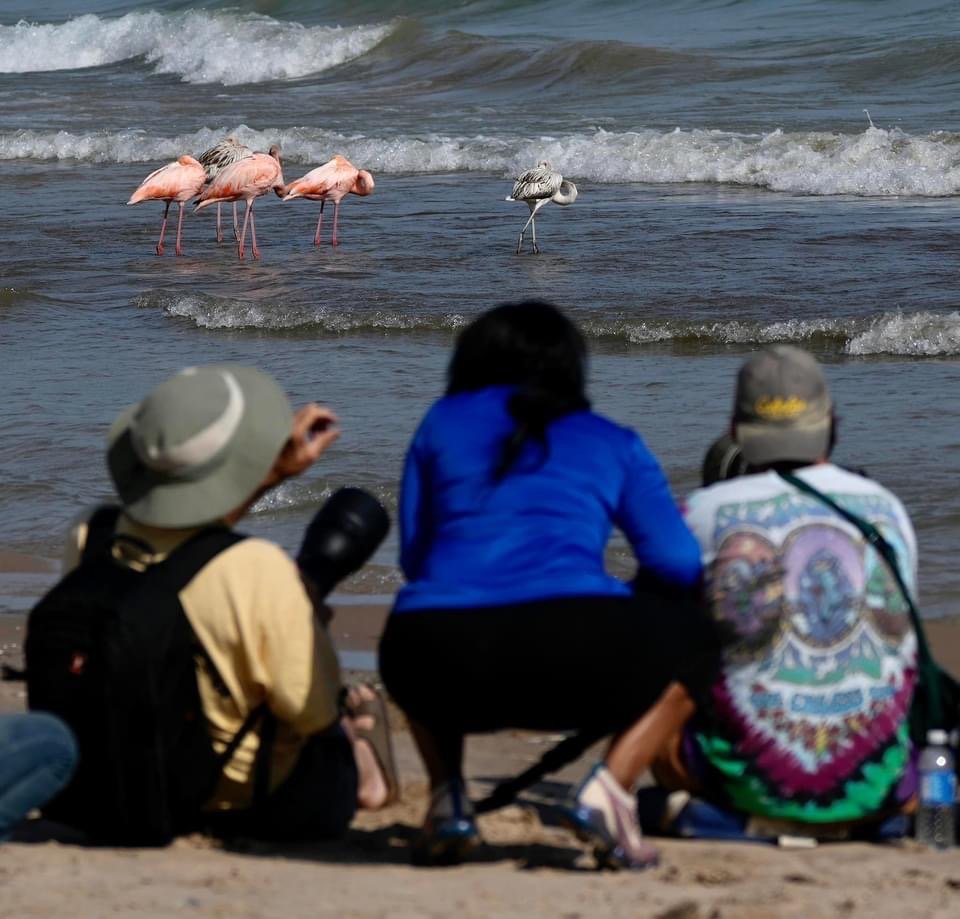Banner photo: the six Idalia flamingos, phone-scoped at St. Marks NWR
August 31 by Kathleen Carr.
Three adult and two immature American Flamingos, strolling in Lake Michigan at Port Washington, Wisconsin. Admirers in the foreground enjoyed a first ever reported sighting in that state. Photo by Mike de Sisti. (Facebook)
What started out as a local curiosity the day after Hurricane Idalia swept across Florida has become a once in a lifetime bird dispersal event across much of the eastern United States. Flamingos have been showing up in Florida (over 70!), all along the Gulf Coast and inland—Alabama, Texas, the Carolinas, Tennessee, and Kentucky. They have even been seen as far north as Ohio, Pennsylvania, and Wisconsin!
Watch the video below to learn more about this phenomenon and read two local accounts.
A Flamboyance of Flamingos
by Kathleen Carr
The day after Idalia passed through our area of North Florida, August 31 2023, I went to the Facebook page for St. Marks NWR and saw that they had posted a Facebook Live event just 10 minutes earlier, at 12:35 PM. It showed some birds wading in the Lighthouse Pool. Couldn’t really tell what they were, and I wondered what prompted the staff to do a live event. Then the camera zoomed in and I saw why— a flamboyance of SIX FLAMINGOS was strolling through the pool, three of them gray immatures! I immediately called Karen Willes, an AAS member who’s been a longtime fan and photo documentarian of Pinky, the American Flamingo. He showed up at St. Marks NWR in 2018 after Hurricane Michael and presumably was carried in by the storm. She had been alerted and was already on her way to the refuge. “See you soon!” I told her.
My husband James and I grabbed our binoculars and spotting scope, jumped in the car, and headed down to the refuge. We were delighted to see that the birds were still there when we arrived. A fair number of observers were parked along the road, but thankfully they were being quiet and not disturbing the birds. We spent a couple of hours watching the flamboyance stroll together from one end of the pool to the other, resting, grooming, and feeding, amazed at nature’s resilience. These birds had been through what must have been an incredibly traumatic experience.
On our way out of the refuge, we stopped by Stoney Bayou 1 where Pinky was off foraging, apparently unaware that there were others of his kind just a few miles away. That changed later that week when the immature flamingos were seen hanging out with him, and then a female joined him. (The size differential between the two birds indicates that he’s probably a male.) No apparent courtship behavior, but it’s not that season. Read the article below for an overview of our local Pink Wave.
The Pink Wave at SMNWR
Published anonymously September 18, 2023 on the NFLbirds Google Group
Birding listserv for the North Florida area (as well as South Georgia and South Alabama)
On August 30, 2023, Hurricane Idalia slammed into the Big Bend coast bringing with it, Category 3 winds, a dangerous storm surge and an undetermined, but very large, number of American Flamingos. After Idalia’s passage flamingos were reported as far north as Pennsylvania and Ohio in what is being called the Pink Wave.
Several Idalia flamingos had been banded in the Yucatan peninsula. These birds may have been moving between there and Cuba when they were entrained in the hurricane. Florida Audubon’s website has some good information on this.
St. Marks National Wildlife Refuge has had a resident American Flamingo for almost five years since Hurricane Michael brought one up in 2018. Lately, that flamingo has been on Stony Bayou 1. On the afternoon that Idalia made landfall east of the refuge, six additional flamingos appeared on Lighthouse Pool; three adult birds and three juveniles. Those birds stayed through the next afternoon before flying west.
The next morning, two days after the hurricane’s passage, two adult flamingos were seen near the lighthouse moving between Lighthouse Pool and the salt flats across the road. These birds left after a few hours. Over the next two days, no Idalia flamingos were sighted on the refuge. The resident flamingo continued to be seen on Stony Bayou 1.
On Monday, September 4th, five days after the hurricane, an adult flamingo showed up at Lighthouse Pool, where it would stay for two weeks. On that same day, three juvenile flamingos were seen on Stony Bayou 1. One of the juveniles was observed flying away, late in the day. The two remaining juveniles stayed on Stony Bayou 1 for four days, through September 7th.
After Idalia, St. Marks’ resident flamingo stayed on Stony Bayou 1 and was last seen there on September 11th. The Idalia flamingo on Lighthouse Pool was last seen on the 17th.
Some people believe that the Idalia flamingo sightings at St. Marks were the same six birds that came in with the storm, breaking up into smaller groups. However, with as many flamingos as were likely to our north, we may have been seeing flamingos that were moving back south. If these were different birds it would mean a total of thirteen Idalia flamingos passed through the refuge.
Has our resident flamingo finally left? It has disappeared before for short periods of time. Seeing other flamingos may have restarted some social urge to be with its own kind. However, it was not notably social when other flamingos were here. It did feed briefly with another adult bird, but stayed when that flamingo left.
Is this Pink Wave over? Will we see more flamingos as birds in northern states continue to move back towards their normal range in the Yucatan peninsula or Cuba?
Probably a good excuse to go down to St. Marks and search for flamingos. (After the government shutdown if there is one.)


